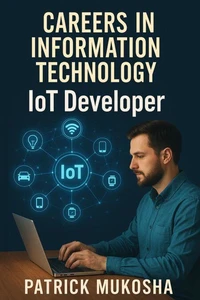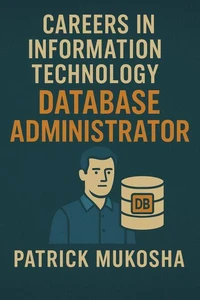“Smart Cities: The Technology Transforming Urban Living”. GoodMan, #1
Par :Formats :
Disponible dans votre compte client Decitre ou Furet du Nord dès validation de votre commande. Le format ePub est :
- Compatible avec une lecture sur My Vivlio (smartphone, tablette, ordinateur)
- Compatible avec une lecture sur liseuses Vivlio
- Pour les liseuses autres que Vivlio, vous devez utiliser le logiciel Adobe Digital Edition. Non compatible avec la lecture sur les liseuses Kindle, Remarkable et Sony
 , qui est-ce ?
, qui est-ce ?Notre partenaire de plateforme de lecture numérique où vous retrouverez l'ensemble de vos ebooks gratuitement
Pour en savoir plus sur nos ebooks, consultez notre aide en ligne ici
- FormatePub
- ISBN8227099273
- EAN9798227099273
- Date de parution13/06/2024
- Protection num.pas de protection
- Infos supplémentairesepub
- ÉditeurBig Dog Books, LLC
Résumé
The Author explores the transformative effects of technology on urban surroundings in "Smart Cities: The Technology Transforming Urban Living." With almost two-thirds of the world's population expected to reside in cities by 2050, urbanization is expected to continue accelerating and bring both enormous opportunities and concerns. This book offers a thorough examination of the ways in which innovative technologies are transforming urban life and improving the efficiency, sustainability, and livability of cities. The trip starts with a thoughtful introduction to the idea of smart cities, outlining their development and importance in the modern world.
Readers are introduced to the technical pillars supporting smart cities, from Artificial Intelligence (AI) to the Internet of Things (IoT), demonstrating how these breakthroughs gather and analyze data to improve many aspects of city living. Smart cities are revolutionizing transportation through the use of driverless vehicles, sophisticated traffic management, and public transit systems that reduce traffic and increase mobility.
Smart collection systems and waste-to-energy technology are two examples of intelligent waste management solutions that show how cities may become greener and more sustainable. The book also examines how technology is revolutionizing healthcare, with telemedicine, remote monitoring, and health data analytics enhancing patient access and tailored treatment. With smart classrooms, e-learning platforms, and measures to bridge the digital gap.
E-government services rethink governance and citizen participation. Finally, the book looks ahead, examining new technologies and the development of smart cities while highlighting the significance of resilience, adaptability, and human-centered design. For anyone interested in the future of urban living, "Smart Cities: The Technology Transforming Urban Living" is an engaging and educational read.
Readers are introduced to the technical pillars supporting smart cities, from Artificial Intelligence (AI) to the Internet of Things (IoT), demonstrating how these breakthroughs gather and analyze data to improve many aspects of city living. Smart cities are revolutionizing transportation through the use of driverless vehicles, sophisticated traffic management, and public transit systems that reduce traffic and increase mobility.
Smart collection systems and waste-to-energy technology are two examples of intelligent waste management solutions that show how cities may become greener and more sustainable. The book also examines how technology is revolutionizing healthcare, with telemedicine, remote monitoring, and health data analytics enhancing patient access and tailored treatment. With smart classrooms, e-learning platforms, and measures to bridge the digital gap.
E-government services rethink governance and citizen participation. Finally, the book looks ahead, examining new technologies and the development of smart cities while highlighting the significance of resilience, adaptability, and human-centered design. For anyone interested in the future of urban living, "Smart Cities: The Technology Transforming Urban Living" is an engaging and educational read.
The Author explores the transformative effects of technology on urban surroundings in "Smart Cities: The Technology Transforming Urban Living." With almost two-thirds of the world's population expected to reside in cities by 2050, urbanization is expected to continue accelerating and bring both enormous opportunities and concerns. This book offers a thorough examination of the ways in which innovative technologies are transforming urban life and improving the efficiency, sustainability, and livability of cities. The trip starts with a thoughtful introduction to the idea of smart cities, outlining their development and importance in the modern world.
Readers are introduced to the technical pillars supporting smart cities, from Artificial Intelligence (AI) to the Internet of Things (IoT), demonstrating how these breakthroughs gather and analyze data to improve many aspects of city living. Smart cities are revolutionizing transportation through the use of driverless vehicles, sophisticated traffic management, and public transit systems that reduce traffic and increase mobility.
Smart collection systems and waste-to-energy technology are two examples of intelligent waste management solutions that show how cities may become greener and more sustainable. The book also examines how technology is revolutionizing healthcare, with telemedicine, remote monitoring, and health data analytics enhancing patient access and tailored treatment. With smart classrooms, e-learning platforms, and measures to bridge the digital gap.
E-government services rethink governance and citizen participation. Finally, the book looks ahead, examining new technologies and the development of smart cities while highlighting the significance of resilience, adaptability, and human-centered design. For anyone interested in the future of urban living, "Smart Cities: The Technology Transforming Urban Living" is an engaging and educational read.
Readers are introduced to the technical pillars supporting smart cities, from Artificial Intelligence (AI) to the Internet of Things (IoT), demonstrating how these breakthroughs gather and analyze data to improve many aspects of city living. Smart cities are revolutionizing transportation through the use of driverless vehicles, sophisticated traffic management, and public transit systems that reduce traffic and increase mobility.
Smart collection systems and waste-to-energy technology are two examples of intelligent waste management solutions that show how cities may become greener and more sustainable. The book also examines how technology is revolutionizing healthcare, with telemedicine, remote monitoring, and health data analytics enhancing patient access and tailored treatment. With smart classrooms, e-learning platforms, and measures to bridge the digital gap.
E-government services rethink governance and citizen participation. Finally, the book looks ahead, examining new technologies and the development of smart cities while highlighting the significance of resilience, adaptability, and human-centered design. For anyone interested in the future of urban living, "Smart Cities: The Technology Transforming Urban Living" is an engaging and educational read.






















